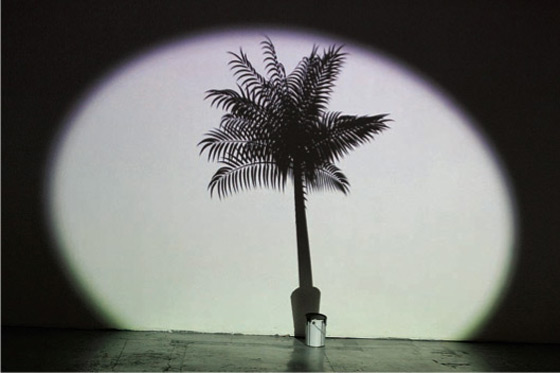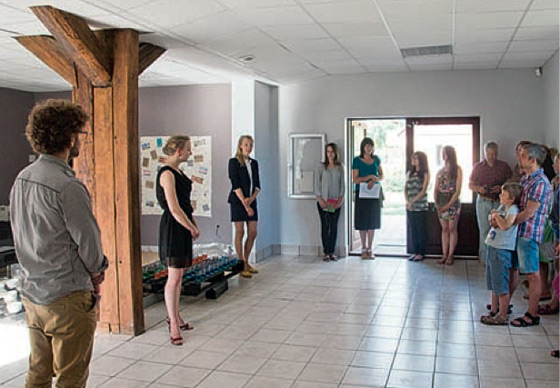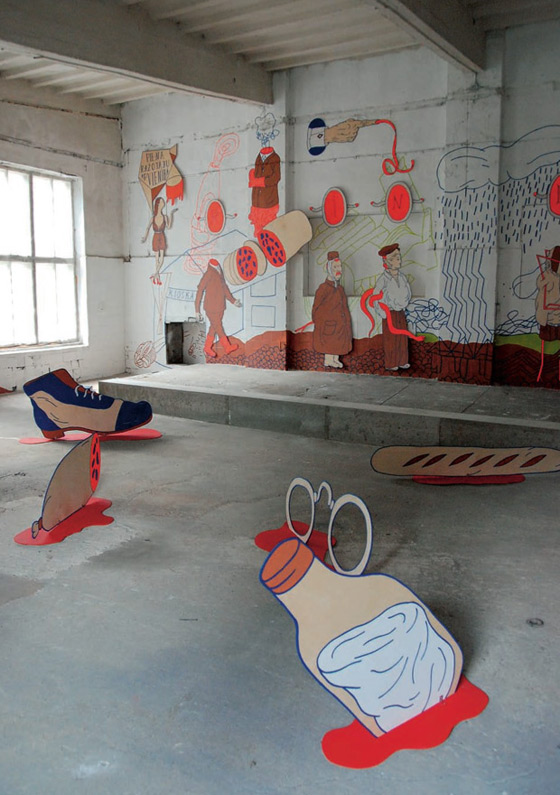|
|
| “Summer Art” tourism Maija Rudovska, Art Critic, Curator | |
| With the warm summer nights, swimming, wearing shorts and pick- ing berries starting to fade away at the end of the season, one must start evaluating how much thought, attention and meaningful re- flection, overshadowed by the above-mentioned, has been devoted to art – to the events, festivals, initiatives and impulses that materialised outside Riga, in the provincial towns of Latvia, in the outskirts, in cultural centres, former breweries, on lakeshores and elsewhere. What was this “summer art” like (if it can be referred to as such, without adding a little note of irony to the word already)? What were its aims? And what audiences did it address? In this article I will turn my attention to two events: Art Festival Cēsis and the pop-up art space jūrK. I will also examine the possible links and connections that gave rise to or that served as the basis for organising these and similar events. Among the points of reference mentioned – selected quite subjectively – others could be included, too, for instance, the art festival RojaL in Roja, the art activities Notes on Tukums in Tukums, and others. To my mind, they all have one aim – to make incursions into or to promote interaction with peripheries (here and henceforth in the text I am referring to “territorial peripheries”) which may include an undiscovered place or abandoned building, or just about any outlying location and provincial town in Latvia. It doesn’t matter whether it is a festival in which the accent has been on art in the public space, thus trying to address or engage as big an audience as possible, or on the transfer of the white cube to some marginalised environment: these events reflect efforts to make contemporary art come alive or to present an introduction to it. | |
 Vadim Fishkin. Miss Christmas. Installation. 2012 Publicity photo Courtesy of Irina and Māris Vītols | |
| The pop-up art space jūrK in the Jūrkalne parish of Ventspils district is active only for the summer season, namely, from 15 June till 23 August, because – according to its initiator Linda Sīle – this is the time when the place is visited by tourists, who are there mainly for the sea. During the season there was on view an interactive project Jūrkalnes zelts (‘The Gold of Jūrkalne’) by Laura Prikule and Eva Vēvere, the exhibitions Liesma groziņa formā (‘A Flame in the Form of a Little Basket’) by Romans Korovins, Tradīciju nešana (‘Carrying on Traditions’) by Evelīna Deičmane, Doma piepilda telpu (‘Thoughtfilled space’) by Krišs Salmanis and a joint work by Kate Krolle and Atis Jākobsons, Patiesība ir vienkārša (‘The Truth is Simple’). All of the authors and also Odrija Fišere, the curator of this series of exhibitions, had more or less attempted to “converse” with the local environment, to find the best possible forms of expression so that the art would look and belong here naturally, as if not trying too hard. For instance, Deičmane spent several days in Jūrkalne in order to create fragile, site-specific works reflecting on her state of mind and the time spent there. Prikule and Vēvere, in their turn, played a game of golden cube hide-and-seek, creating intrigue and involving the local inhabitants in the hunt. The general intention and arrangement of the space overall are attractive enough for it to turn into, hopefully, an annual event of “summer art” and an exciting experience not only for the artists and their friends looking for a retreat by the sea. The ease and playfulness characteristic of the event at the moment, offering numerous and diverse modes of expression, doesn’t make it too serious. However, to be honest, I haven’t got a clue as to the extent and depth of impact this exhibition and activities may have left in the hearts of local inhabitants of Jūrkalne, or some tourist visiting temporarily. Although, evidently, there were provocations that reverberated beyond Jūrkalne. Namely, soon after the opening of Krišs Salmanis’s exhibition ‘Thought-filled space’ (27 July–8 August), I read in the local newspaper Kurzemnieks numerous infuriated opinions about the exhibition “in which there isn’t anything” and which “turned [viewers] into fools”. Indeed, apart from the souvenir stand which as a constant “installation” accompanied all the projects, the exhibition really did not exhibit anything – merely a cardboard box with booklets made by Salmanis. The idea, of course, is well-known and simple: by offering the viewers an empty space, they are given the opportunity to create their own works of art on the basis of their experiences, previous interaction with art and their own aesthetic criteria. Similarly, they can choose to participate in the artist’s game and to see “the invisible works of art”. This conception has already been played upon count- less times, for instance, in artworks by Yves Klein, Laurie Parsons, Bethan Huws, Martin Creed and others. One especially chrestomathic example is Klein’s The Void, which in 1958 was exhibited at the Iris Clert Gallery. The exhibition consisted of an almost empty room, with a white-painted glass showcase as the only exhibit. The gallery window had been painted blue and visitors were offered blue cocktails at the entrance. In its own way, Salmanis’s idea was appealing and beautiful, manifesting a wish to give up anything that is unnecessary. To renounce showing, materiality, expectations and interpretations. Leaving only space for thought. Yet in this particular context it disappointed, because the local inhabitants were not able to read it or to understand it. The exhibition remained unfulfilling or completely incomprehensible to people without an in-depth knowledge of contemporary art, or at least the required viewing experience (which, clearly, they are not obliged to have). On the contrary, the exhibition could give rise to a counter reaction and people distancing themselves from similar expressions of art in the future. Such conclusions bring up the question – what kind of art can be appreciated or should be exhibited in peripheries? And why should it actually need to “interfere” there? Strange as it might sound, the current “summer art” involves a certain component of tourism and entertainment, and without these elements it would not be able to take place. And that, probably, is no bad thing (if one does not have unduly great expectations). “Nice entertainment for a weekend,” wrote Vilnis Vējš in his review of the Art Festival Cēsis(1), and you can only agree. The Art Festival Cēsis, which this year was the seventh in a row, has become a locally prominent event considered as a ‘must-visit’ by any cultural person from Riga. Since the very beginning it has been ambitiously planned and generously financed. It has presented not only the visual arts, but also music, performance art, film, dance and other art and culture subbranches. Despite the extensive advertising and invited “celebrities”, the loud words and local awards, its visual arts section (excepting the achievements of certain artists or curators) has unfortunately always been poor and unconvincing. This year was no exception, with rather clumsily constructed expositional arrangements and relationships, although many of the artists’ works individually were captivating and interesting. | |
 Krišs Salmanis. View from the exhibition Thought-filled space Publicity photo Courtesy of the artist | |
| The exhibition part of the visual arts programme consisted of three as if mutually unrelated exhibitions: a project nurtured by Ieva Kulakova with a hitherto unseen compilation of works by Visvaldis Ziediņš under the title Bezdibenis. Visvaldis Ziediņš (‘Abyss. Visvaldis Ziediņš’; at Cēsis Exhibition hall); an international art exhibition Vasaras lasījumi (‘Summertime Readings’) organised by Ķęstutis Kuizinas, Lithuanian curator and director of the Lithuanian Contemporary Art Centre (at the Cēsis brewery and public locations in town), as well as a solo exhibition Portraits (at Cēsu Printshop) by the young photographer Karlīna Vītoliņa. The keynote of the festival was deter- mined by the approach chosen by Kuizinas: to reveal the relationship between fiction and non-fiction, the imaginary and the real, or the very narrow and ambiguous borderline that divides these assump- tions, or allows us to identify them, though the exhibition organised by Kulakova to a certain degree reflected the framework of this conception. Not intentionally, of course, because the formats were different – Summertime Readings was more diffuse and interacted with the architecture of the old brewery, more or less successfully, while the exhibition Abyss. Visvaldis Ziediņš, in its turn, was displayed in an exhibition hall, and in terms of the arrangement took on a more fixed form. However, what made both exhibitions different was the fact that Abyss offered anthropological material and an approach that may be defined as “classical” and familiar to the Latvian cultural milieu. This time the organisers were not carried away by stories and mythology, if only in the documentary material where the image of the artist-genius still prevails. The exhibited objects were classified according to their genre (for example, the portrait) or according to the technique of execution (graphic art / drawings, sculptures / objects), and supplemented by interviews. Thus the compilation of the works of art at the exhibition did not throw light on the curator’s method or perspective on the contents, but instead simply showed the findings (as if they weren’t a result of certain choices!). Perhaps that is even good, because the role and artistic heritage of Ziediņš is still a “hot potato” which, although labelled with the very contradictory notion of nonconformist art, nevertheless refuses to find its place in the Latvian art history as written thus far. It is interesting to follow the studying, systematization and exposition of Ziediņš’ legacy also due to the very process of institutionalisation: where the facts and findings chime with the perspective of the finder/curator, how they are presented, how they are formulated and where they are then placed. In this aspect, Kulakova’s project fitted within the conceptual framework of Kuizinas almost too well. As regards the exhibition Summertime Readings and its various spatial units and parts, it elicited rather mixed feelings. The cartography of the exhibition was shaped both by provocative and entertaining works of art that in terms of their volume were striking and funny, and also introvert and in terms of their expression sensitive works that demanded concentration and more attentive viewing. I presume that for those viewers who expected some kind of visual surprise from art, the most appealing was the impressive group of sculptures Sunday (2013) by Donatas Jankauskas, located at the entrance, or the attractive installation Kharms Beat (2013) by Maija Kurševa, inhabited by slightly weird cardboard characters revealing, as usual, the artist’s personal mythology. Similar works in terms of visual parameters, filled with the absurd, contemporary satire and metaphor, and perhaps in their formal mode of expression playful or unserious, were Leonards Laganovskis’s objects Tribīnes (‘Tribunes’; 1998– 2013) and Eduards Kļaviņš’s animation Dollijas briljanti (Dolly’s Diamonds; 2013). Among the quieter works, both literally and metaphorically, there was Sebastian Diaz Morales’s video Pasajes I & II (2012–2013), as well as The Archive (2012–2013) by Virginia Colwell. Morales’s video work featured an anonymous gentleman walking around Buenos Aires, thus symbolically presenting an alternative model of geography, and superbly complemented the empty, abandoned premises of the brewery with its interesting architecture that offered a special experience per se. Colwell’s work, on the other hand, fitted Kuizinas’ conceptual setting possibly the most accurately of all, because it reflected on memories and the construction of history, where facts turn into the imaginary, and the imagined – into potential real life occurrence. The works of art mentioned above represent only some of the material presented at the exhibition, but to the author of this article at least they seemed the most outstanding and memorable examples. At the conclusion of this review, mention must be made of Vadim Fishkin’s work Miss Christmas. With its projector- generated image of a palm-tree “growing” out from a pot of paint, this work served as a tourist attraction in the most direct sense, be- cause you could take photos next to it just like the Tower of Pisa. And for the majority of people born in these geographical latitudes the palm-tree stands for something like an unattainable paradise. All in all, the exposition left the impression of cacophony – numerous diverse modes of expression and form, contexts and discourses, all brought together in the one, not so easily assimilated space. | |
 Maija Kurševa. Kharms Beat. Installation. 2013 Publicity photos Courtesy of the artist | |
| Both the Art Festival Cēsis and the modest project jūrK makes one reflect on the formats of the exhibitions and their desirability or necessity in the context of “summer art”. Is showing, exhibiting, educating, attracting and entertaining the main goal and purpose for organising such events? With the contemporary art festival Survival Kit 5 approaching, this year being dedicated to the core subject ‘The Slow Revolution: Art and Culture in Institutional and Territorial Peripheries’, the polemic about relations between peripheries and centres will definitely be pursued in a broader context. Nevertheless, already prior to the event a question arises about the “occupation of peripheries”, or the mode and form of interaction that is involved, the knowledge that is constructed about it, and its future use. Most often, following the best traditions of enlightenment, peripheries are offered new knowledge that is considered better than the existing, and an exhibition for some reason is recognized as the best method to do so. To my mind, an excellent example for the explorations of new spatial parameters and relations is the work This Way Brouwn (1960) by an artist of American origin, representative of Fluxus and conceptualism Stanley Brouwn. In the creation of this work Brouwn visited Rome, where he asked various strangers he met to draw the way to a popular basilica. Always asking for one and the same destination, he received countless quite different routes that revealed a variety of understandings of a place and space which each of the local inhabitants thought they knew so well. Translator into English: Laine Kristberga (1) Vilnis Vējš. Stāstītāji un lasītāji. Review of the Cēsis Art Festival 2013 www. arterritory.com/lv/teksti/recenzijas/2508-stastitaji_un_lasitaji._recenzija_par_cesu_ makslas_festivalu_2013/ (accessed on 19.08.2013) | |
| go back | |







